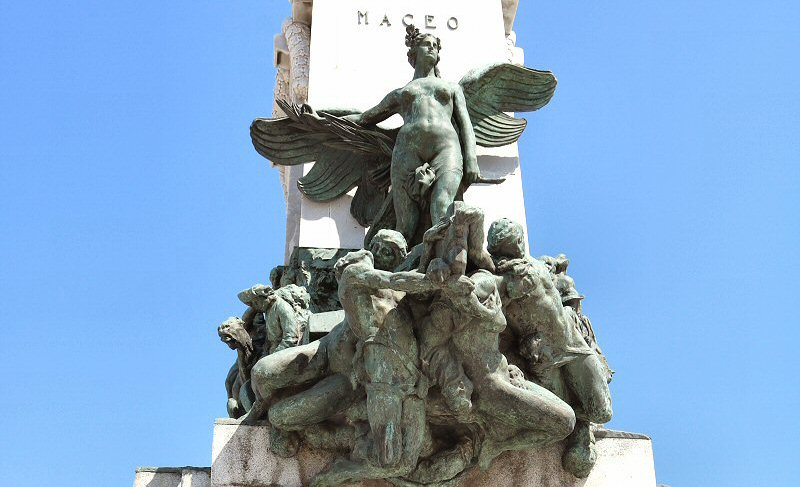

The statue of Antonio Maceo was the most
transcendental work of the Italian Domenico Boni. He made also
the sculptures of the Conde de Pozos Dulces and General Mambí
Alejandro Rodríguez that were erected in Vedado. He completed
the work in Italy in four years. 1916, when he arrived in Cuba,
he lost his life by an honor duel. Subsequently, his project was
modified in a way that it will also touch the heart of the
Spaniards living in Cuba.
The monument with the bronze equestrian
statue of the hero at the top, consists of the shaft, the high
reliefs and the granite pedestal.
Antonia Maceo is represented, dressed in
his military uniform on the galloping horse. He holds a machete
in his right hand and encourages his soldiers to attack the
enemy. The statue is positioned with his back, facing the sea,
as if implying that Antonio Maceo was not a native Cuban
(Antonio Maceo, the Bronze Titan, was born in Santiago de Cuba).
During the Ten Years’ War, the Spanish spread rumors about
Antonio Maceo that he initiated a racist struggle against the
white people in the island, as he had a black skin. Therefore,
this detail of the statue was the subject of intense polemics in
Havana.
On the upper part of the shaft of the
monument, there are the Coat of Arms of Cuba and Havana. The
shaft is covered by large high reliefs. The relief in front of
the monument shows the mother of Antonio Mace, Mariana Grajeles,
in the act of administering her children the oath to remain
faithful to the fatherland. Mariana Grajeles (1815-1893)
consecrated her life to the fight for the independence of Cuba
and encouraged all of her children and her husband for this
goal. The large reliefs around the shaft refer to some important
events that had a special place in the life of Antonio Maceo:
the battle of Mejíta, Protesta de Baraguá, the battle of
Cacarajícara and La Indiana Coffee Combat.
Mejíta is a rural settlement in the
municipality of Norris in Holguin that served as a camp for the
Mambis during the Ten Years’ War. In 1877 a strong combat
between the Spanish troops and the Mambi forces took place here,
in that Antonio Maceo was seriously wounded, but the uprising
against the Spanish persecution became an epic.
The peace agreement known as the Zanjón
Pact in 1878 that ended the Ten Years’ War, was not accepted by
the Major General Antonio Maceo, even though Arsenio Martínez
Campos, the Governor of Cuba, met the Mambi forces in Baraguá to
persuade the commanders to lay down arms. He declared that he
would continue the battle against the Spanish for an independent
Cuba. This event is known as Protest of Baraguá.
The battle of Cacarajícara constitutes
one of the most glorious pages of the military history of Cuba.
At a critical point, when the situation of the insurgents,
composed of only 170 poorly armed men, gets worse under the
attacks of the Spanish column of nearly 1.000 soldiers,
commanded by the Spanish General Julián Inclán, Colonel Juan
Ducasse that just returned from an expedition, reached the scene
with 150 men and a lot of ammunition, so that the rebels forced
the enemy to retreat. The turn of the battle led Antonio Maceo
to declare that the victory was in sight.
In 1871 the Liberation Army, commanded
by Máximo Gómez, attacked the fortified coffee plantation La
Indiana that served as a military camp for the Spanish Army.
This action is known as La Indiana Coffee Combat.
At each corner of the pedestal stands a
sculpture, representing action, thought, justice and law.
The park/square around the monument
occupies and area with a length of about 400 meters and a width
of about 60 meters. Even though, new fountain and benches were
added to the park, it still lacks any tree. The wide square
around the monument is surrounded by Chinese grass.